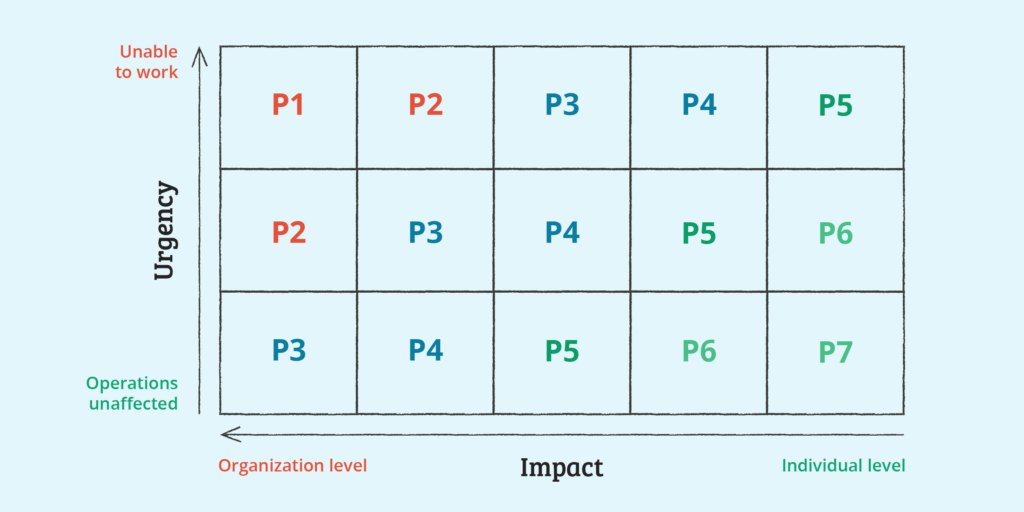Incident Priority Matrix: the key to more effective Incident Management

Your IT department's ability to accurately prioritize and swiftly resolve IT incidents directly impacts its overall efficiency – not to mention how happy your end users are.An important tool in making your Incident Management processes more effective is the Incident Priority Matrix. This blog explains what an Incident Priority Matrix is and why it matters, offering practical steps and best practices for implementing one.
What is an Incident Priority Matrix?
The Incident Management Priority Matrix is a tool used in IT service management (and ITSM software), specifically in Incident Management, to prioritize and categorize incidents based on their impact and urgency. As you can understand, it’s also known as the Impact and Urgency Matrix. It helps service desk employees determine the importance of an incident and how quickly it needs to be resolved.
But how do you decide what counts towards impact and urgency? Consider the following four questions:
- How is productivity affected?
- How many users (and what type of users) are affected?
- How many systems or services are affected?
- How critical are these systems/services to the organization?
Think of impact as the shockwave unleashed by an incident—does it disrupt vital business activities, or is it merely a hiccup affecting a single user like John in Accounting? The greater the disruption, the higher up the priority ladder the incident climbs.
On the other hand, urgency is all about the ticking clock. It's the stress test of how quickly a resolution is required. High-stakes incidents that grind business functions to a halt are tagged with high urgency, demanding immediate action.
An Incident Priority Matrix maps the impact and urgency of an incident on one axis each.
The benefits of an Incident Priority Matrix
An Incident Priority Matrix makes it easy to see at a glance whether you're dealing with a high urgency incident or something that can wait a little while longer. It gives your IT department a clear overview of what needs to be picked up when and means major tasks are dealt with quickly, while more minor tasks are still handled within an acceptable time frame. As a bonus, it also teaches your team the right kind of thinking, so that they can start prioritizing tasks correctly more quickly.
When you implement an Incident Priority Matrix, your IT department can tailor its incident response plan and strategy, making sure resources are focused where they are needed most, maintaining efficiency, and minimizing disruptions.
An Incident Priority Matrix in action
To use TOPdesk as an example (because we know our own organization best): we work with an Incident Priority Matrix that uses five different levels of impact: organization, location, department, team and person.
As for urgency, we find that just three levels are ideal for most organizations: critical, normal, and low. This is what our Incident Priority Matrix looks like:

Understanding the outcomes of an Incident Priority Matrix
Using our Incident Priority Matrix gives us seven levels of incidents, going from Priority 1 (a critical incident) to Priority 7 (a minor annoyance).
Critical priority tasks
A critical incident (Priority 2 and above) usually involves urgent issues like:
- Major system failures
- Widespread network outages
- Data corruption
- Legal or regulatory ramifications.
Imagine a crucial server crash disrupting operations or classroom technology going offline; these scenarios require immediate attention to prevent severe business impact.
Normal priority tasks
Normal priority tasks usually have Priority 3-5 assigned to them, meaning:
- Basic functions are available, but limited
- Usually more than one user is affected
- Workarounds are available to a certain extent.
Examples are malfunctioning printers or essential software not opening on some computers. These issues are important but can afford a bit more time for resolution.
Low priority tasks
Then there are low priority tasks, which fall below Priority 6 and cover minor nuisances. These are attended to after more critical work is completed.
Using Service Level Agreements with your Incident Priority Matrix
At TOPdesk, we also apply Service Level Agreements (SLAs) to handling incidents of different priority levels. Of course, this will vary from organization to organization. You can, for example, use the following Service Level Agreements:
- For a Priority 1 issue, you can expect a response within 15 minutes. If it remains unresolved by the 30-minute mark, you can expect an escalation.
- For a Priority 2 incident, you could commit to up to 4 hours as a reasonable resolution time, with an escalation in the 5th hour if a solution cannot be found.
- A Priority 3 task could receive a resolution time of up to 8 hours, with an escalation if unresolved afterwards.
- A Priority 4 incident would get a full 24 hours, et cetera.
How to create your own Incident Priority Matrix
Follow these four steps to create your own Incident Priority Matrix:
1. Define impact and urgency levels
Categorize incidents from high to low impact and urgency, considering factors like the number of affected users and business dependencies.
2. Develop priority levels
Use a combination of impact and urgency to establish for instance five levels of priority—from the highest priority to minimal. This could look like critical, high, medium, low, and minor.
3. Implement visual aids
Create diagrams or charts to represent these priority levels. Visual representations help in easily assigning priorities in the incident management process.
4. Integrate with ITIL best practices
Align with ITIL's Impact Urgency Priority Matrix to maintain consistency and effectiveness.
Best practices for using an Incident Priority Matrix
Introducing an Incident Priority Matrix has many benefits. To make the most of it, stick to the following best practices:
Establish straightforward criteria for your Incident Priority Matrix
Use straightforward criteria for what's considered urgent and impactful so there's no doubt possible – and make sure not only your team knows, but your end-users do too. This way, you ensure everyone in your team assesses incidents consistently, and your end-users know when their problem needs to take a backseat.
Educate your team on using an Incident Priority Matrix
Providing practical training on how to use an Incident Priority Matrix and what its many benefits are, like faster problem-solving and improved service, can help ease the transition to using one.
Update your Incident Priority Matrix when relevant
Lastly, remember that your Incident Priority Matrix needs occasional updates to stay aligned with changing business priorities. By addressing these issues calmly and methodically, you can refine your incident management process effectively.
How TOPdesk's ITSM software supports Incident Priority Matrixes
TOPdesk's ITSM software includes a built-in Incident Priority Matrix that takes the guesswork out of prioritizing incidents. By using predefined impact and urgency levels, TOPdesk automatically prioritizes incoming incidents based on the information provided by end users, such as how many people are affected or whether their work is blocked. End users can also flag potential emergencies in the Self-Service Portal, giving high-priority attention right away, which the IT team can later verify.
You can also link the Incident Priority Matrix to your SLAs to track performance and spot areas for improvement and even automate alerts to ensure the right people are notified for high-priority incidents. This makes your incident response process faster, smoother, and more efficient. Discover what TOPdesk's ITSM software can do for your IT department.
FAQs about Incident Priority Matrixes
1. What is the primary purpose of an Incident Priority Matrix?
The main purpose is to categorize and prioritize incidents to ensure efficient and swift resolution based on their impact on users and urgency.
2. How does urgency differ from impact?
While impact assesses the broad effect on business operations, urgency focuses on the speed required to resolve incidents.
3. Can the Incident Priority Matrix be adjusted for different organizational needs?
Yes, an Incident Priority Matrix can and should be customized to align with specific business processes and priorities.
Get started with your own Incident Priority Matrix
Using an Incident Priority Matrix is crucial for optimizing your incident response strategy and improving your IT operations. Try it out yourself! Download our Incident Priority Matrix template.
Inspire others, share this blog


